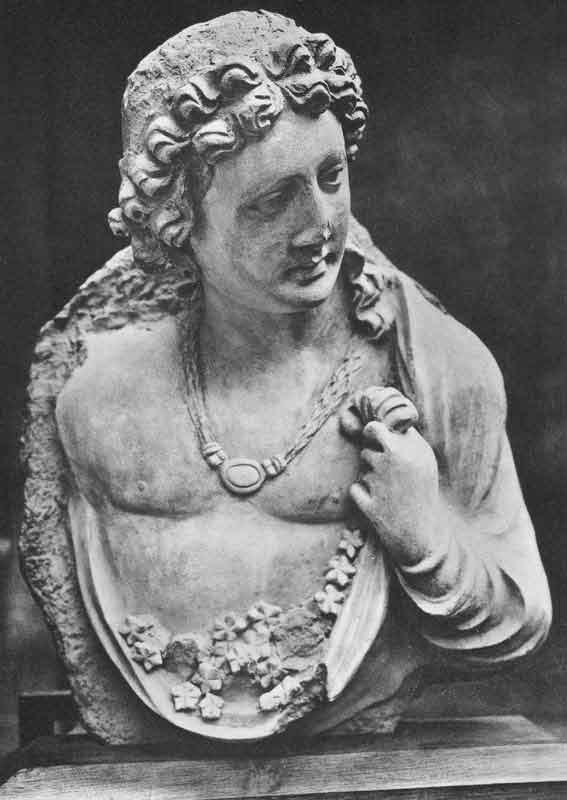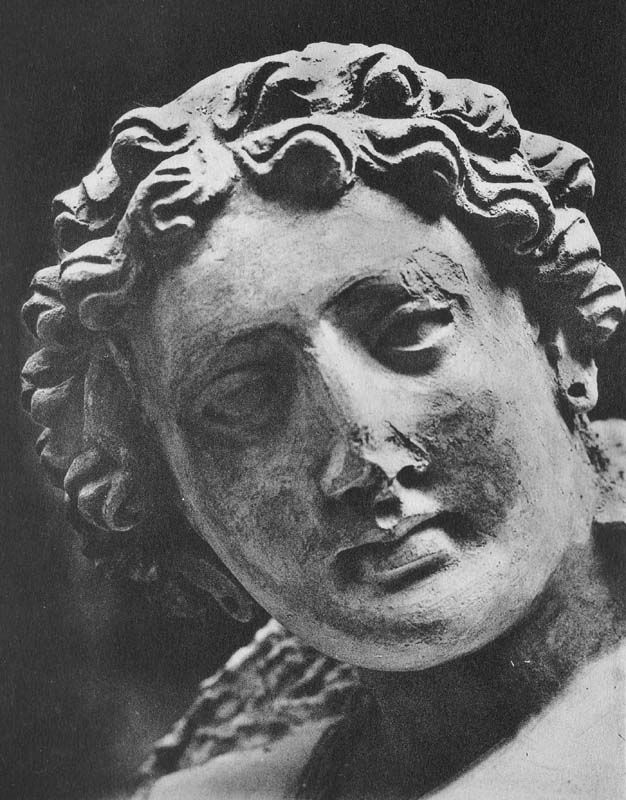Bust of Genius with Flowers
Tapa Kalān - Figure
The Genius with Flowers is one of the most famous pieces among those found at Haḍḍa and was the subject of an article by Alfred Foucher (Foucher, 1930). It was discovered in a nearby chapel of stūpa 140. At the back of a caitya, on a platform, stood a walking Buddha (estimated to be about 220 cm high) surrounded by two other statues of 90 cm to 100 cm, placed in each corner. On the wall placed symmetrically to the flower genie was another bust, an orant in añjalimudrā which collapsed when it was being cast.
Ancient texts report that some gods only manifested themselves halfway up the body, which the artists probably wished to illustrate here. The genius drew with his right hand (now lost) a whole supply of flowers contained in the sinus of his uttarīya, held by his other hand, in order to rain petals on the Buddha. Shirtless, he wears a necklace made of a large chain with an oval medallion set in it. Although this work is of exceptional quality, it does not appear to be the work of a particular, identifiable genius. In this setting, he belongs to the cohort of devout "helpers" whose backgrounds Buddhist artists cover with paintings or bas-reliefs. He is a genius among many others, a devaputra (son of god), a divine being of some kind. He has no lakṣana, sign or attribute that could classify him among the great gods. His role as a flower-throwing orant is always lent to ordinary geniuses.
Observation :The Genius with Flowers has been compared with the Antinous Vertumne in the Lateran and the Zephyr in the Tower of the Winds in Athens. This comparison has raised questions: was it a simple meeting or a direct imitation? A. Foucher believes that what counts, more than the posture and gesture, is the intention. Here, it differs completely. In the classical world, this posture would be an allegory of the spring season. In Buddhist mythology, it is the common gesture of the deva to honour the Blessed One. The Hellenistic character is obvious: supple and symmetrical arrangement of the hair curls around the forehead, perfect oval of the face, nervous modelling of the eyes and lips. It is a beautiful face, reminiscent of certain portraits of Alexander the Great. But here the similarities end, for only the face is Greek. The shawl is Indian, as are the flowers, apparently jasmine. The jewellery is Indian: bracelets on the wrist, a medallion held by chains on the chest. And of course, the deformed earlobes. One can notice that the holes in the ears are empty. It is possible that it was for the attention of the pious donors to put real jewels there. Without these purely Indian details, Foucher believes that one could almost attribute the flower genie to the school of Lysippus, at the end of the fourth century BCE. At the end of his demonstration, the scholar concludes that this work is probably not the result of a direct imitation. According to him, the striking contrast between the body and the head could be explained by a separate manufacture, by two different hands. But, he adds, he is sure that they were made for each other and at the same time. He formulates a hypothesis: the head would be from a relatively old mould, preserved in the workshop and only the bust would indicate a low period. We see the generalisation of this technique in Haḍḍa. Both faces from the same mould and some of these moulds have been found. This is what best explains, according to him, this incongruity. "For the Indians, it was a figure more adoring than adorable, made half in the mould and half modelled" (Foucher, 1930).
Bibliographical References :BARTHOUX Jules - 1930 - Les Fouilles de Haḍḍa, Figures et Figurines - Pl. 37 et 38
FOUCHER Alfred - 1930 - Buste provenant de Haḍḍa - pp. 101-110


